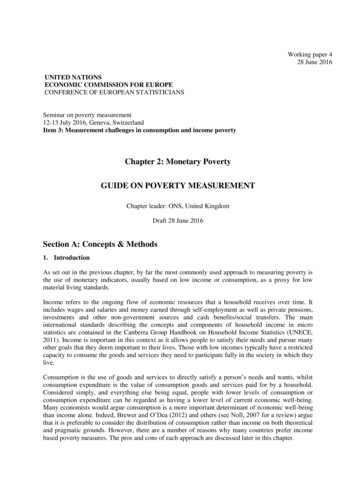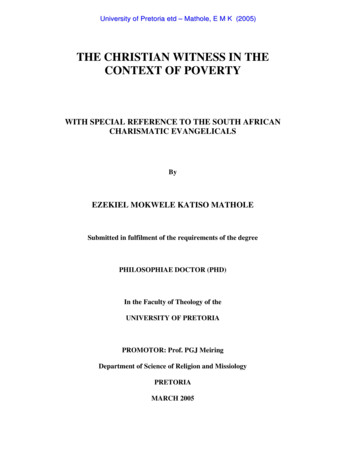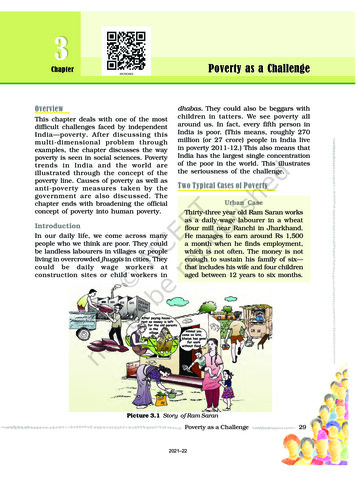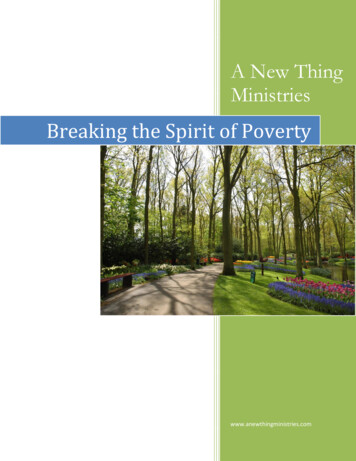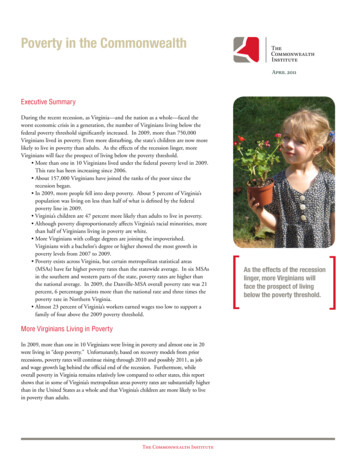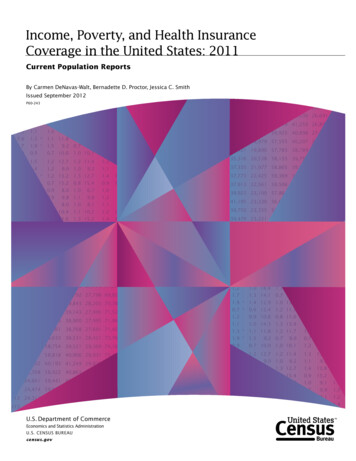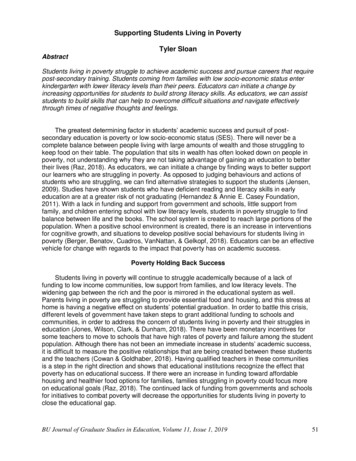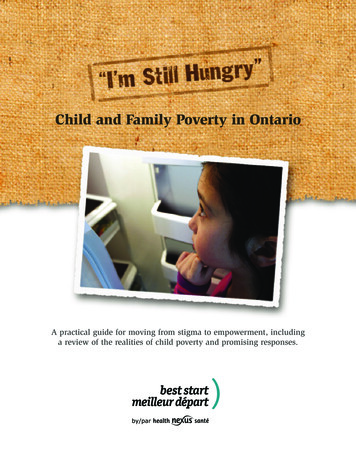
Transcription
REDUCINGPOVERTY THROUGHAGRICULTURE
Cover: Mable Chikombo, with young Michelo on her back, Zambia.Photo: Anders Hansson cover, pages 5, 14, 16, 18, 20, 27, 31.Nick Sells page 2. Marcus Lundstedt page 6.
ure is the key to reducing poverty7The poorest of the world’s population make a living from farming7The most effective way to lift people out of poverty7Agriculture provides jobs – where there is no other employment8Increased equality yields more sustainable agriculture9The farmers need to organise themselves12Small investments can make a big difference12Land is an increasingly important resource12Future challenges and potential in agriculture15We Effect on the ground17Agriculture must be restructured19Climate change threatens agriculture19Agriculture contributes to climate change19Other negative environmental impact from agriculture21Sustainable agriculture that is productive21We Effect on the ground23Economic prerequisites for sustainable agriculture24The way forward26We Effect on the ground28Abbreviations29Sources29Reducing poverty through agricultureAuthor: Agneta Gunnarsson and Mats Wingborg.This report is published with support from Sida. Sida has not participated in production and responsibility for the content restswith the publisher.Editors: Niclas Ericsson, Fredrik Moberg. Production: Treativ. Printing: Danagård LithoWe Effect, SE-105 33 Stockholm, SwedenTel: 46 (0) 8-120 371 00 Website: www.weeffect.seISBN: 978-91-977467-7-9
REDUCING POVERTY THROUGH AGRICULTURE“ANYONE WHO WANTS TO FIGHT FOR THEPOOR PEOPLE OF THE WORLD MUST ALSOFIGHT FOR THEIR AGRICULTURAL LIVELIHOODS.”Agriculture is facing a number of challenges. Con-percentage of Swedish support goes towards developingsideration for the environment, ever more mouthsagriculture in poor countries.to feed and helping to reduce poverty in the world. Focusing on small-scale agriculture. There are severalIt will be difficult, but it is possible.million small family farms in poor countries with just a fewWe know that investing in agriculture reduces poverty andhectares each for growing crops and providing for them-hunger. However, we also know that agriculture throughoutselves. Support for this type of agriculture reaches many ofthe world has a direct and indirect impact on practically all thethe world’s very poorest people.major environmental problems, from loss of biological diversityto climate change. We are perhaps the first generation with Focusing on agriculture that is sustainable and buildsthe knowledge and resources to alter the trend. Nevertheless,strong communities. That means social and economicwe are not doing enough of what we know is needed.sustainability, but obviously consideration for the climateand environment is also required for social and economicWe Effect has compiled this report to provide a summary ofimprovements.the current knowledge at hand about sustainable, smallscale agriculture as a necessary and effective way to combat Focusing on women. They constitute more than half of thepoverty and hunger. At the same time it can contribute topoorest population in rural areas, so at least half of agricul-reducing climate and environmental impact.tural development cooperation support should go to them.In order to restructure agriculture to meet the challengesObviously much more is needed;of the future, changes are required. Here in Sweden weinternational agreements mustcan make a difference, through development cooperationbe altered and poor countriesand by pursuing a policy for more efficient and sustainablethemselves must also focus moreagriculture with a diversity of crops and production methods.on increased social, economic andThis type of agriculture not only produces food but alsoecological sustainability in theirgives the farmers so much more – cleaner water, natural fer-farming. However, the insight wetilisation of the soil, resistance to pests and a more balancedwant to communicate in our reportand varied diet. It creates work and gives families the meansis simple:to provide for themselves.Anyone who wants to fight for the poor people of the worldSome essential points for Swedish development coopera-must also fight for their agricultural livelihoods.tion are:Anneli Rogeman, To direct a greater proportion of development coopera-CEO We Effecttion support towards agriculture. Today only a small-4-
-5-Nancy Wairimu Kamande, Kenya
“Small-scale farmers often lack access tothe necessary technology”Read more on page 12Miguel Adolfo Gonzalez, Nicaragua-6-
AGRICULTURE IS THE KEY TOREDUCING POVERTYAgriculture has a key role to play in food securityareas, making a living from agriculture, fishing or forestry.throughout the world and lifting people out ofHowever, production is seldom sufficient to avoid hungerpoverty, but at the same time there are a number ofand malnutrition. This creates negative spirals. Malnutritionchallenges to be faced. These include a continuallyimpairs people’s physical capability and increases suscepti-growing global population with new demands forbility to illness, which in turn reduces their facilities to lookfood, fuel and raw materials, plus the fact that aafter the family farm in the best way, for instance.switch to more sustainable and climate-smart farNot only do several hundred million people go to bedming methods is needed.hungry every day; a total of two billion people are sufferingThe whole chain from field to table needs to be morefrom a lack of micronutrients and 500 million are affectedresource-efficient with reduced levels of waste. Food secu-by obesity in the world4. In other words, sustainable con-rity naturally also involves fair distribution. The food pro-sumption is an essential issue for both rich and poor, in theduced must be made available to those who need it most,northern and southern hemispheres.and productivity and food quality in areas where people arecurrently suffering from hunger, malnutrition and povertyTHE MOST EFFECTIVE WAY TO LIFT PEOPLE OUT OFmust be improved in a sustainable manner.POVERTYThe 2008 World Development Report was entitled Agricul-THE POOREST OF THE WORLD’S POPULATION MAKE Ature for Development.5 It was the first time since 1982 thatthis heavyweight among multilateral organisations laun-LIVING FROM FARMINGAccording to the UN, around 1.2 billion people are living inched an annual report about agriculture. The World Bankextreme poverty, which means that they are living on USDpointed out in its report that it was time to put agriculture1.25 or less per day. Three out of four of these people liveback at the heart of the development agenda becausein rural areas and the vast majority of them make a livingeconomic growth within agriculture is at least twice asfrom agriculture or occupations linked to agriculture.effective as growth within other sectors with regard to12reducing poverty. However, despite the fact that severalThe latest calculations from the Food and Agriculture Orga-years have passed since the report was published, sup-nization of the United Nations (FAO) indicate that almostport for agriculture in developing countries has only800 million people in the world are hungry and under-increased marginally.nourished.3 In this group too, three out of four live in rural1. The World Bank, Poverty overview, 2014.2. The World Bank, Agriculture for Development, World Development Report 2008, 2007.4. FAO, Statistical Yearbook 2013, World food and agriculture, 2013.3. FAO, IFA, WFP, State of Food Insecurity in the World, 2015.5. The World Bank, Agriculture for Development, World Development Report 2008, 2007.-7-
AGRICULTURE IS THE KEY TO REDUCING POVERTYAccording to a study from 2010, agriculture is even moreagency UNDP also stresses the importance of improvingimportant than previously believed for lifting people outproductivity within small-scale agriculture.8 UNDP speci-of poverty.6 The study covered some 80 countries andfies three reasons for this. Firstly, increased productivityextended over a period of just over 20 years. It showedin agriculture would contribute to lower prices for localthat growth within agriculture in low-income countriesfood, thus also reducing poverty among those not wor-can be five times as effective as growth within other sec-king in agriculture. Secondly, increased productivity fortors in terms of reducing poverty among those who aresmall-scale agriculture would to a certain extent com-worst off. In Sub-Saharan Africa, agriculture can be tenpensate for the uneven division of access to land, whichtimes more effective than other occupations at liftingoften prevails in developing countries. Farmers with smallthose worst off out of poverty and destitution.plots would also obtain increased income. Thirdly, smallscale agriculture is often labour-intensive, which meansThe studies show that a large proportion of the posi-that increased productivity could increase employment intive effects within agriculture radiate out like rings inrural areas in these countries.water and have an impact on additional sectors throughincreased demand for goods and services.7 This inAGRICULTURE PROVIDES JOBS – WHERE THERE ISturn creates more jobs within trades and services andNO OTHER EMPLOYMENTincreases local consumption. However, reductions inThe percentage employed in agriculture is generallypoverty achieved through more productive agriculturehigher the poorer a country is. According to FAO, Eastare greater if land and resources are fairly equally dividedAfrica is the global region with the highest percentageamong the population. In countries with very unevenof people working in agriculture – 73 per cent.9 The cor-distribution the effects of growth are reduced for thepoor because the positive effects primarily fall to thosewho own the land and other productive assets. The UNresponding figure for South Asia is 47 per cent10 and forChina 35 per cent11. Within the EU, only 5 per cent ofthe population are farmers 12 and in Sweden only 2.5 perIncreasing numbers of poor in rural areas in AfricaThe number in extremepoverty in rural areas(millions of people)While the number inextreme poverty in ruralPercentage of globalGlobal totalSub-Saharan Africa1500areasAlmost three quarters of1200all those living in extremepoverty in the world live900increasing. This means thatan increasing percentageof the very poorest amongthe world’s population livesin rural Africa. Source: FAOOtherpoverty living in ruralareas throughout the worldis falling, in Africa it isLiving in rural areaspopulation in extremein rural areas, and most of600them are wholly dependenton agriculture for their3000306(28.4%)1010(71.6%)livelihood. Source: FAO1988199820086. Nordic Africa Institute, Hårsmar, M., Why is agriculture so important to reducing poverty?Policy Notes, 2010/7.7. Ibid.200811. Trading Economics, Employment in agriculture (% of total employment) in China2014. ulture-percent-of-totalemployment-wb-data.html.9. FAO, Statistical Yearbook 2013, World food and agriculture, 2013.12. European Commission, EU Agricultural Economics Briefs, How many people workin agriculture in the European Union, 2013. s/briefs/pdf/08 en.pdf.10. Ibid.13. FAO, Statistical Yearbook 2013, World food and agriculture, 2013.8. UNDP, Africa Human Development Report 2012 – Towards a Food Secure Future, 2012.-8-
AGRICULTURE IS THE KEY TO REDUCING POVERTYcent13. These differences are also visible in the share ofand make a living from agriculture.17 Positive progress forexample, agriculture accounts for almost half of GNP,fore play a crucial role, not only in terms of equality, butwhile the equivalent figure for Sweden is 1.8 per cent .also in reducing global poverty.The differences in conditions between farmers in indu-The role of women within agriculture and food produc-strialised countries and developing countries is a mattertion is also increasing in most parts of the world. Thisof organisation, access to effective advice, level of educa-trend is especially evident in Sub-Saharan Africa. Men aretion, means to obtain financial services, proximity to mar-increasingly choosing to move to the cities. As a result, ankets and access to technology and input goods.ever greater share of responsibility for agricultural activi-the women on these traditional family farms can there-GNP from agriculture. In Ethiopia and Sierra Leone, for14ties falls to the women; we are seeing the feminisation ofagriculture.More people work within agriculture in low-incomecountries in part due to the fact that agriculture is lessmechanised there and labour is cheaper. A further expla-Better equality within agriculture would also involve othernation – that is bound up with the previous two – is thatgains, in addition to women’s rights being strengthe-small-scale family farms dominate in poor countries.ned. Studies from Africa, Asia and Latin America haveFarmed land in these countries comprises 95 per centshown that the whole family often benefits from womensmall-scale farms of less than five hectares each, whileachieving enhanced status and power within the family.only five per cent is made up of large-scale agriculturalWomen generally allocate more money for food, health-operations. In industrialised countries, 90 per cent of allcare and education. This gives children better access toagricultural land is generally used for large-scale agricul-nutritious food and girls get a better education. The facttural operations.that girls get an education often results in them not get-15ting pregnant until later in life and having fewer children,This means that in poor countries there are several mil-which, among other things, signifies important healthlion households running small-scale family farms of just abenefits for women in developing countries.18few hectares each.According to FAO, harvests are 20 to 30 per cent higherINCREASED EQUALITY YIELDS MORE SUSTAINABLEin agricultural activities controlled by men. This differenceAGRICULTUREcan be linked to the fact that men often have betterAccording to FAO, women account for on average 43 peraccess to labour, information, input goods and machi-cent of the workforce within agriculture in developingnery. Another explanation is that women are often left tocountries. In Sub-Saharan Africa and South and East Asiatake care of the least fertile land. If women had the samethis figure is higher. Here, women carry out half of theopportunities as men, these differences could be drama-agricultural work, and in some countries even more.tically reduced.19 If female farmers could increase their16harvests by 20 to 30 per cent, i.e. to the same level as theIn all, approximately 70 per cent of the poorest peoplemen’s, the extra amount of food would be sufficient toin the world are women, most of whom live in rural areasreduce the percentage of malnourished people by 12 to14. Ibid.17. Kooperation Utan Gränser (now We Effect), Världens tuffaste jobb (The toughest job inthe world), 2010.15. FAO, What do we really know about the number and distribution of farms and familyfarms in the world?, ESA Working Paper No 14-02, Sarah K. Lowder and others, 2014.16. FAO, The State of Food and Agriculture, Women in Agriculture, closing the gender gapfor development, 2011.18. Ibid.19. FAO, The State of Food and Agriculture, Women in Agriculture, closing the gender gapfor development, 2011.-9-
AGRICULTURE IS THE KEY TO REDUCING POVERTYThe world’s poorest countries aredependent on agricultureThe map shows by colour how much ofeach country’s GNP comes from agricultureand by fill pattern what percentage ofemployment is provided by agriculture.The picture is clear: The world’spoorest countries are largelydependent on agriculturePercentage of GNP fromagriculturePercentage employedwithin agriculture 3% 3%HONDURAS3 – 10 %3 – 20 %GUATEMALANICARAGUAEL SALVADOR10 – 20 %20 – 40 %20 – 30 %40 – 60 % 30 % 60 %The average figure for theThe average figure for theregion has been used for theregion has been used forfollowing countries, owingthe following countries,to lack of specific countryowing to lack of specificdata: Benin, Burkina Faso,country data: China, NorthBurma, Djibouti, Estonia,Korea, Sudan, WesternGreece, Guinea-Bissau, Haiti,SaharaIraq, Iran, Israel, Cameroon,Source: FAOBOLIVIAPARAGUAYKuwait, Liberia, Mali, Niger,Nigeria, North Korea, Oman,Palestine, Qatar, Serbia,Somalia, the Czech Republic,Venezuela, Western Sahara,East Timor.Source: FAO- 10 -
AGRICULTURE IS THE KEY TO REDUCING NIAPALESTINEBURMA/MYANMARCAMBODIAVIETNAMTHE PHILIPPINESUGANDAKENYATANZANIASRI LANKAMALAWIZAMBIAZIMBABWEMOZAMBIQUEWe Effect aroundthe worldWe Effect is working todevelop small-scale agriculturein 24 of the world’s poorestcountries, which are namedon the map.- 11 -
AGRICULTURE IS THE KEY TO REDUCING POVERTY17 per cent. This in turn would mean between 100 andSMALL INVESTMENTS CAN MAKE A BIG DIFFERENCE150 million fewer hungry people in the world.One way to improve the economic conditions for small-20scale agriculture and rural areas would be to developDespite this, women often have limited influence overactivities, including processing of foodstuffs, somethingdecisions relating to agriculture. Therefore it is crucial tothat was highlighted in a report from the UN’s formerinvolve women in decisions relating to development andSpecial Rapporteur on the right to food, Olivier de Schut-preservation of agriculture, sustainable use and equitableter. 22 One strategy to accomplish this is to focus on localdistribution of the natural resources from biological diver-investments within storage, processing, packaging andsity. The position of poor women needs to be strengthe-sales of the products. Simple things such as a dryingned and their knowledge, skills and experience utilised .plant or facilities for packing fruit and vegetables in a21commercially marketable way can give smallholders newincome, which yields profitability for their activities.THE FARMERS NEED TO ORGANISE THEMSELVESThe leaders of the African Union promised back in 2003to focus more on agriculture, in the so-called MaputoHowever, small-scale farmers mostly lack access toDeclaration. Only a handful of African countries havethe necessary technology, capital and financial servi-so far lived up to the promises made in the declaration.ces. Many live in remote and poor areas where lack ofPoliticians rarely prioritise small-scale agriculture, which isinfrastructure and long distances to markets hamper salesan obstacle to long-term sustainable solutions to the struc-and set-up of food processing activities. FAO states thattural problems in agriculture. Smallholders in rural areas infarmers who have small margins often prefer to save anydeveloping countries are also often poorly organised andprofits as insurance to be used in the event of a crisis rathermarginalised. This limits their political influence and theythan invest the money.23often have little scope to demand political responsibilityFamily farms in developing countries often have littlefor the lack of investment.potential for obtaining credit. One way to increase accessIf the farmers were to come together in cooperatives andto credit can be for smallholders to come together and setother types of member organisations, however, they couldup saving and loan groups. Such farms often have need ofbe stronger financially. This could make it easier to pay forother forms of financial services such as insurance. Otherinvestments, and give the farmers access to new marketstypes of networks like producer cooperatives can promoteand a stronger bargaining position in relation to largeinvestments and processing of foodstuffs.grocery chains and other buyers. Organisation also opensup opportunities for learning, training and dialogue.LAND IS AN INCREASINGLY IMPORTANT RESOURCESmall-scale agriculture often has limited scope for deve-Poor profitability and hard manual labour mean that agri-lopment due to lack of land or uncertain land rights. Whenculture today attracts ever fewer young people in low andfarmers do not know if they will get to farm the land in themiddle-income countries. Strong farmers’ organisationsfuture, this generally reduces interest in making invest-and the possibilities they can offer in the form of influ-ments. Another reason is that farmers often lease or haveence, access to financial services, knowledge, new incomepermission to use land owned by larger landowners with-potential and social connections can help to raise the status of agriculture.20. Ibid.21. International assessment of agricultural science and technology (IAASTD). The study wascarried out between 2005 and 2008 and resulted in one global and five regional reports andthe synthesis report Agriculture at a crossroads.22. UN, Report submitted by the Special Rapporteur on the right to food, Olivier deSchutter, 2010.23. FAO, Food Loss and Food Waste, 2014 & FAO, Food Wastage Footprint, Impacts onNatural Resources, 2013.- 12 -
AGRICULTURE IS THE KEY TO REDUCING POVERTYout having any guarantee of being able to farm the land inagricultural activities on the territory. In such instancesthe future.foreign capital can help to develop agriculture in a positive direction for the local population. In other cases theWomen are particularly disadvantaged with regard topurchase may be solely a way to manage capital or gene-access to land. According to FAO, women control aroundrate short-term returns. The worst forms of such purchases12 per cent of the land in South and South-east Asia, 15 perare often called land grabbing, which aims to take controlcent in Sub-Saharan Africa and roughly 20 per cent in Latinof the land away from the local population and no long-America. However, these figures conceal large variationsterm sustainable investment in agriculture takes place.25Companies in financially-strong countries are particularlybetween individual countries.24likely to be involved in leasing or buying up land.26 Oneeffect of the foreign purchases is the risk of land pricesIn many developing countries land has also become aninternational capital investment. Land is purchased orrising, which can make it more difficult for small-scale far-leased for a prolonged period by foreign investors. Someti-mers to develop their agricultural activities.mes the purpose is to pursue sustainable forestry orHow We Effect works in developing countries WE EFFECT conducts activities in 24 countries inin order to reduce poverty and injustice: ruralAsia, Africa, Latin America and Europe. Our deve-development, housing & habitat, access to land,lopment cooperation efforts are always long-term,gender equality and financial services.preventive and sustainable. In order to ensure thechanges are lasting, we work together with local OUR FOCUS on rural development is motivatedorganisations on the ground. And always with theby the fact that the majority of the world’s poor livebasic idea of supporting self-help initiatives.in rural areas and investment in small-scale agriculture is one of the most effective ways to reduce WE EFFECT is involved partly in dealing with thepoverty. Work on rural development includesconsequences of poverty: lack of food, lack ofattempting to influence decisions that may lead toadequate housing, insecurity and lack of influence.sustainable and climate-adapted agriculture, andHowever, we also want to change the structuresto agricultural reforms and trade rules that favourthat cause poverty: rules and laws that do notthe poor. The result is food on the table, incomefavour poor people, lack of democracy, equalityfrom harvests and people coming together to haveand human rights.a shared voice in society.TO ENABLE PEOPLE to rise out of poverty, they WE EFFECT works on financial services, inclu-need to be able to produce food, obtain incomeding saving and loan groups, microloans, insu-from their harvests and have adequate housing.rance and assistance with price negotiations.We Effect therefore focuses on the following areas24. FAO, The State of Food and Agriculture, Women in Agriculture, closing the gender gap for development, 2011.25. IIED, FAO & IFAD, Land grab or development opportunity? Agricultural investment and international land deals in Africa, 2009.26. Holden, J. and Pagel, M, Transnational land acquisitions, 2013.- 13 -
Matreswaran Vanithanchani andMatreswaran Anushiya, Sri Lanka.- 14 -
FUTURE CHALLENGES ANDPOTENTIAL IN AGRICULTUREAgriculture offers a number of possibilities forlifting people out of poverty and hunger, whichDIFFERENT TYPES OF AGRICULTUREhave been described above. However, there are alsoGlobal agriculture covers everything from large,a number of challenges to be faced.mechanised agricultural operations, in bothindustrialised countries and developing countries,If today’s consumption and population trends continue,to small family farms in developing countries,the Food and Agriculture Organization of the Unitedoften consisting of just a few hectares of land orNations (FAO) calculates that global food productionless, generally tended using hand tools and moreneeds to increase by approximately 60 per cent bytraditional methods.2050. At the same time many people are moving away27from rural areas and depopulation represents an obstacle to increased productivity. Another obstacle is, as acept usually includes that agriculture should strive forcontradiction, the fact that the fight for land and naturala diversity of crops and production methods, be basedresources is increasing in many places. This is particularlyon local conditions and resources and make the most oftrue for many poor countries where resources are inade-ecosystem services. Ecosystem services are the naturalquate and the biggest population increase is expected.resources that ecosystems provide, e.g. air and waterpurification, pollination of crops, natural pest control andbinding of carbon.Achieving the required increase in production whilecontinuing as we have to date is not possible. This wasestablished by the biggest interdisciplinary study ofIn addition to the environmental aspects, sustainableagriculture carried out to date.28 The study, which wasdevelopment also includes a social and an economicpresented in 2008, has been followed by a series of otherdimension. The former is based on building a societyreports asserting that large areas of agriculture through-where basic human needs are met and the latter strivesout the world need to make fundamental changes infor secure livelihoods and balanced economic develop-order to cope with supplying a growing population andment.at the same time improving sustainability and reducingthe climate and environmental impact of agriculture.Globally, agriculture is one of the biggest sources ofgreenhouse gas emissions. However, sustainable agricul-There are many different definitions of what is envisagedas environmentally-sustainable agriculture, but the con28. International assessment of agricultural science and technology (IAASTD). The study wascarried out between 2005 and 2008 and resulted in one global and five regional reports andthe synthesis report Agriculture at a crossroads.27. FAO, World Agriculture Towards 2030/2050: The 2012 revision.29. Ibid.- 15 -
FUTURE CHALLENGES AND POTENTIAL IN AGRICULTUREand increased almost threefold in Indonesia. However,in Sub-Saharan Africa productivity only increased marginally. Few countries are currently self-sufficient in terms ofstaple foods and the need for food aid is still great.30 Inother words, the green revolution did not increase accessto food universally. In addition, it has been criticised forlarge-scaleness, use of fertilisers and pesticides, unsustainable land cultivation and more. The distribution effectsare also disputed; while some researchers maintain thatthe green revolution increased the economic gaps inrural areas, others feel that the poor have also benefitedfrom production increases.A new genuine green revolution is now needed. However, unlike the one that took place 50 years ago it musttake into account environmental and climate aspects,and be based on the situation for small-scale agriculturein developing countries, which currently represents themajority of producers and also produces the greatestvolume of food. It is essential to build on biological diversity rather than large monocultures and to get away fromthe idea that one solution fits all. Such diversified agriculture should be based on local circumstances and incorporate environmentally-adapted methods such as agroforestry and natural pest control. In addition, economicalAuditor Mudenda, Zambiause of water is required so that more food is producedper litre of water, including growing less water-intensiveture could contribute to reducing the negative climatecrops and storing rainwater for dry periods.impact through production methods that bind carbon inthe soil and through planting trees as well as reducedThe issue of whether agriculture can provide for a gro-use of fossil fuels. But agriculture employing sustainablewing global population is also a matter of equitablemethods is not growing at a rapid enough rate to meetdistribution and whether the agricultural produce beingthe challenges of the future.produced can be better utilised. A high level of waste iscurrently to be found in all elements of production. In richIn the 1960s the so-called green revolution led to dra-countries, waste is mostly created by shops and house-matic production increases in several quarters, prima-holds, while in low-income countries it is primarily harvestrily through new high-yield varieties of rice and wheatand storage losses. FAO has calculated that one third ofbeing introduced 29. Several countries in Asia quicklyall food is never actually used as food
LIVING FROM FARMING According to the UN, around 1.2 billion people are living in extreme poverty, which means that they are living on USD 1.25 or less per day.1 Three out of four of these people live in rural areas and the vast majority of them make a living from agriculture or occupations linked to agriculture.2
